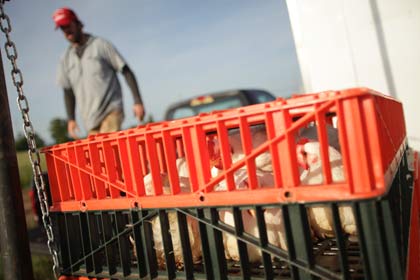Clad in a worn tan Carhartt jacket and rubber boots as insurance against the rain threatened by a slate-gray, wind-wiped spring afternoon, Derek Brandow is in his element — multiple elements, really. Today, the former elementary school teacher’s classroom is a field of knee-high grass, his young student a potential customer for the community-supported agriculture (CSA) subscriptions that Our Family Farm, his poultry operation, is selling. After raising backyard laying hens for two years and learning about the horrors of factory-scale poultry farms, that customer-to-be, a precocious preteen girl, is determined not to eat chicken unless she can inspect the farm herself and see that the flock is raised under humane conditions and allowed to express their avian nature, their very chicken-ness.
That makes her the perfect customer for Brandow, a part-time poultry grower and local standard-bearer for the farm-to-table movement. A bearded, genial bear of a man, with an ever-present grin crinkling his hazel eyes, Brandow squats beside the slim, bleached blond pre-teen next to a mobile pen, getting on her level and addressing her questions and concerns directly and seriously. He shows no hint of the abruptness or condescension that could be expected of a busy farmer pestered by the questions of a child prying into his world. He explains how he pasture-raises his birds, moving their protective pens about the field daily so that they have fresh grass to crop and bugs to scratch for and how he supplements their diet with locally processed chicken feeds. He gently catches a white-feathered, red-wattled pullet from the flock, bunched close together for warmth and companionship on this blustery day, in order to give the young lady he is clearly charming an up-close introduction.
Later, he’ll blog triumphantly about winning her “seal of approval.” That’s how Brandow likes to work, building his customer base and growing the farm-to-table movement through face-to-face interactions, by sharing stories and by building a community of like-minded people dedicated to good food, responsible animal husbandry and stewardship of the land. The farm-to-table movement (or field-to-plate as it is alternatively called) is one face of the slow food movement: the push for sustainable agriculture, regional and seasonal-based diets and support for smaller farmers in the face of an increasingly mechanized, globalized, corporatized, chemically dependant agricultural system. A handful of dominant corporations control more than 80 percent of the beef industry; more than 60 percent of pork production and over half of the poultry are grown nationally, squeezing small to mid-sized farmers out of local markets. To counter this trend, advocates of the farm-to-table movement strive to produce two things: food grown in the healthiest, most sustainable way possible and a customer base aware of the linkage between farmers, farm communities, time-honored food production practices and the way our food affects our health and our culture. A key part of countering the trend is coming to the Willamette Valley: mobile slaughter.
Portrait of a modern farmer
In his mud-caked rubber boots, jeans and camouflage baseball cap, Brandow, 38, certainly looks like a born farmer. The full-time manager of a local outlet for telephone giant AT&T, he spends much more of his time in an immaculately pressed suit and tie. Brandow follows a state trend: While the average farmer is in his mid-sixties and on the verge of retirement, those newly joining the profession tend to be in their middle years with outside jobs.
A native of Portland, Brandow received an undergraduate degree from the University of Oregon, where he planted a huge garden in the off-campus house he shared with friends, growing “so many tomatoes I didn’t know what to do with them,” he says. After earning a master’s in education from Pacific University, Brandow taught first grade in Springfield before spending two years in New York City, where he taught fourth graders in Harlem and business courses for the fashion house Estée Lauder.
 |
| Brandow checking in on chicks in the brooder |
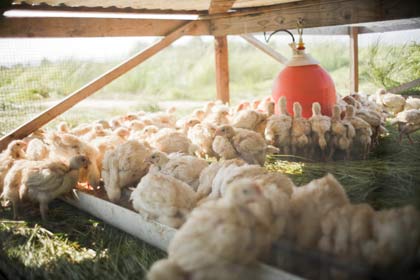 |
| Pullets inside the Salatin-inspired chicken tractor |
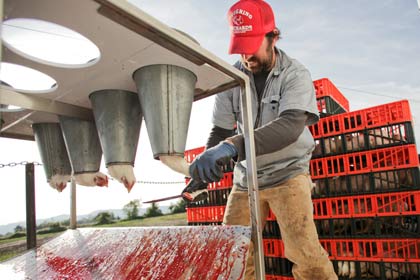 |
| Brandow prepares to cut the arteries of his locally raised chickens before they are processed in the MPPU |
 |
| Poultry moving through the Mobile Poultry Processing Unit |
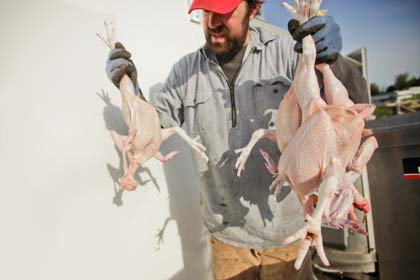 |
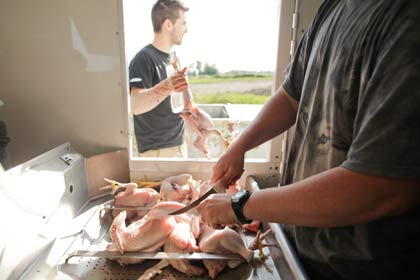 |
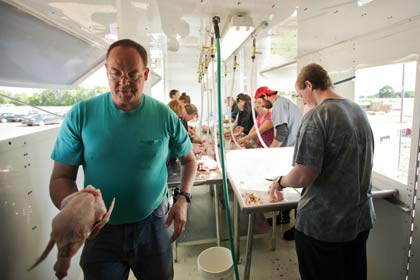 |
Returning to the Willamette Valley, Brandow read environmental journalist and food activist-cum-philosopher Michael Pollan’s The Omnivore’s Dilemma, a polemic on America’s abysmal dietary habits. Inspired by Pollan’s quest to discover a balanced, sustainable, place-based dietary ethic, Brandow began to immerse himself in the literature of sustainable agriculture. From Pollan, Brandow learned of Joel Salatin, the Virginia-based farmer/iconoclast well known in farm-to-table circles for his strident defense of small, pasture-based meat production.
According to Salatin’s theories, sustainable farming starts with caring for the soil, which Salatin accomplishes by mimicking nature. Wild birds flock behind grazing herds to pick through manure, feasting on nutrient-rich grubs and insects while spreading the natural fertilizer that grows the grass so high. Instead of raising fryers in massive warehouses and sending young steers to be force-fed in confined feeding operations, Salatin and his followers practice a careful rotation on their pastures, moving cattle, sheep or other grazers from plot to plot, with their chickens bringing up the rear in mobile pens to massage the waiting manure into the soil beneath their scratching feet.
In 2010, Brandow volunteered at Afton Field Farm — learning how to raise and butcher fowl from Tyler Jones, who interned at Salatin’s Polyface Farm, and how a good processing facility is set up. Brandow says it felt good to be part of a holistic process, working with good people and creating healthy, appetizing food. Always aware of the ultimate sacrifice farmers ask of their flocks, Brandow says he took time each butcher day, almost ritualistically, to thank the birds for sustenance they would soon provide for people. At the same time, he started Our Family Farm on rented pastureland, growing 400 birds that friends and family members eagerly snapped up.
Encouraged by his early success, Brandow built more mobile cages and raised more than 3,500 birds in 2011. His customer base grew to include local restaurants, such as Holy Cow, Nib, Belly and Marché, as well as Long’s Meat Market and Capella Market. Firmly entrenched in the local cuisine scene, Brandow has turned his efforts towards building a direct customer base via a 300-strong email list, a blog and a Facebook page. “It seems like everyone wants to hear what’s going on,” he says. “Restaurants are our bread and butter now. But we want to get our birds into people’s homes directly.” Our Family Farm’s CSA has grown from a single subscriber in 2011 to seven this year and sells fryers to another 30 customers regularly.
Farm-to-table philosophy
A later afternoon sun beats down on a creamy yellow house in north Eugene. Brandow sits in the shade of his covered porch with his wife Amanda, his 15-month-old daughter Addison squirming in his lap. It’s pick-up day for Our Family Farm’s CSA customers and time for some community building. As people show up, the Brandows chat with them, catching up with customers who are or are becoming friends. Sharing the farm’s latest developments and the sustainable eating topic du jour, they learn, in turn, about those they feed. Brandow says the most fun part of his job is being able to connect with people on a regular basis around food, getting to know them and hearing their stories. He might talk to a customer for 10 minutes at pick-up time. “One of the things we love to do is share what we’re doing in a way that inspires other people,” he says, echoing a basic tenant of the farm-to-table movement. “My wife and I are all about a community of smart eaters.”
Brandow says Our Family Farm operates with three guiding principles. The first is careful stewardship to heal the land, much of which in the Willamette Valley is affected by pesticides and other damages of conventional agriculture. “But, other side of coin, there is so much available here,” he says. “People don’t realize the bounty.” This leads to the second principle: to raise some of the best food in the valley. Our Family Farm intends to expand beyond the chickens and turkeys it now raises and introduce cows, sheep or other grazing animals to its fields, fully utilizing a Salatinesque pasturing technique to satisfy local demand for sustainably produced meat. Brandow’s final and overriding goal is to contribute to a growing community of people making sustainable food choices, through his own farming, by supporting other small farmers through his family’s own purchasing power and by outreach.
“I think he definitely seems committed to the movement for slow and local food,” says Bill Bezuk of Eugene Backyard Farmer, a vocal proponent of urban homesteading and local sustainable food production. Bezuk and Brandow have been discussing the possibility of holding chicken butchering demonstrations for urban homesteaders with unwanted roosters or non-productive laying hens. The process can be intimidating to the uninitiated, Bezuk says, and a demonstration could provide customers with the confidence and empowerment to process their own birds if they choose.
The pinnacle of Brandow’s outreach happens each butcher day. A volunteer work crew of about a dozen people assembles to harvest the birds many will soon eat. “It’s a collection of customers, friends and people who are interested in good food and the process,” Brandow says. The crew consists of friends, family members and, perhaps most importantly, Brandow’s customers putting farm-to-table philosophy in action: informed consumers taking an active part in making the food they will eat. Also part of the crew are a contingent from the Junction City Gleaners — gleaners gather food from fields and orchards that otherwise would go to waste.
“We’ve just been realizing in the last few years how important your diet is,” says gleaner Cindy Clark of Cheshire, who adds that she was horrified by factory farming conditions and practices she learned about from documentaries that show how thousands of haggard, debeaked chickens are crammed into rows of small cages in massive warehouses, never exposed to sunlight and open air. “You certainly wouldn’t want to go back to commercial chickens after this. The comparison is dramatic.”
Mobile chicken slaughter
A gleaming white fifth-wheel trailer sits in a 40-acre field off of Highway 36 near Junction City that Our Family Farm shared with another part time farmer during its first two years of chicken raising. Brandow is jazzed about this trailer, visibly excited. The 8-by-33-foot trailer represents an Oregon agricultural milestone and the fruition of years’ worth of planning and hard work. The trailer, which will be Oregon’s first licensed mobile poultry processing unit (MPPU) after passing final inspection later this month, is designed to make the process of turning live poultry into kitchen-ready meat with as little stress and trauma for the birds and work crews alike. Instead of being crated up and trucked more than 30 miles to the closest brick-and-mortar processing plant, the fowl can rest calmly in their pens until almost the last minute before workers stage them next to the butchering floor.
Inside, two rows of gleaming, stainless steel tables face each other under banks of florescent lights, so that Brandow’s volunteer crews will be able to socialize while working, sharing recipes, family gossip and rocking out to music blaring from a portable stereo system. The atmosphere will be the polar opposite of the notoriously hazardous conditions of industrial packing plants, where processing speeds are kept so high that repetitive stress injuries and accidents are commonplace.
As YES! Magazine notes, the consolidation of the meat industry has led to the closing of many small meat processing plants, “leaving mom-and-pop livestock farmers with few if any options for turning their animals into legal-to-sell meat.” Mobile processing units like Brandow’s may be the solution. According to ODA Food Program Manager Jim Postlewait, once the facility is licensed each farm that uses it can process up to 20,000 birds a year under the U.S. Department of Agriculture (USDA) exemptions and state regulations.
Lauren Gwin, co-coordinator of the Niche Meat Processor Assistance Network, says that the new mobile unit is one of only a handful of such facilities nationwide. “Overall, I’d be surprised if there were 20,” she says. “There are probably a dozen.”
Farmers raising 1,000 birds or fewer can process their fowl in open-air abattoirs but can only sell their fryers on the farm. Under USDA and state regulations, those growing up to 20,000 fowl a year can build a state-licensed brick-and-mortar facility or transport their birds to such a facility. But a facility that meets Oregon Department of Agriculture (ODA) standards is a big investment. With no commercial poultry processing facilities in the southern Willamette Valley, local farmers who want to grow more than 1,000 birds or sell off-premises have to budget the time and money to travel to one of the 15 facilities elsewhere in Oregon.
In 2010 Brandow began discussing the benefits of a mobile processing unit with Rachel Prickett of Provenance Farm in Philomath. After broaching the idea with the ODA, Brandow recruited Brian Schack of the Schack Farm in Junction City, who had the skills to construct a mobile processing unit and a trailer bed on which to build the unit. Working closely with the ODA, the three took their time to design a compact, highly functional MPPU. “It’s taken about a year and a half to go from the thought process to a rig driving down the road,” Schack says.
“They didn’t chintz on things,” Postlewait says, adding that while various people have discussed constructing a MPPU for about a decade, the Willamette Valley partners are first to build one. “They’ve got a lot of money in it; they’ve spent a lot of time.”
After gaining experience in running the MPPU and determining operational and transportation costs, the three partners plan to make the unit available to other small farmers. Postlewait says the plan may benefit small producers because it would be more economical to rent the MPPU than build an expensive facility to process a few hundred to a few thousand birds a year, while using the licensed mobile unit would allow farmers currently limited to on-premise sales by the 1,000-bird exemption to sell at farmers markets.
But success is not assured. Gwin points out that in addition to arranging logistical issues such as scheduling and crews to run the unit, the partners will have to calculate a rental fee that will recoup their investment while remaining low enough to attract poultry farmers working with slim profit margins. She says that it is common for the perceived demand for processing plants to be higher than the actual demand once a unit is built. “They have the potential to support farmers, but the farmers have to support them,” Gwin says.
Outreach
In the growing darkness of a late summer afternoon, Brandow is busily feeding chicks and remolding the new brooding pens in an old barn on a grassy 38-acre plot on the outskirts of Thurston. Brandow’s Our Family Farm has just taken up residence here alongside Jeremy Sherer’s fledgling Havarah Farm. Before buying this property, Sherer’s sum total experience with farming was sharing a single-acre garden and orchard in town. He talks excitedly about his plan to graze cattle and other livestock on lush grass watered by a meandering tributary of the McKenzie River, taking full advantage of Brandow’s experience with pasturing animals in the Salatin model. “We believe in a lot of the same things about farming and our food,” Sherer says, adding that “havarah” is Hebrew for fellowship. “Not just making food, but inviting community participation.”
Helping novice farmers get their hands dirty is just another side of Brandow’s commitment to the farm-to-table movement. In addition to building Our Family Farm’s customer base through his CSA program, Brandow provides the kind of help and mentorship he once received to other small-scale farmers. Trace Thaxton, who works at PeaceHealth, was pasturing horses on 80 acres in Marcola with his partner, Marie Connolly, when they met Brandow, who convinced them that the property was perfect for raising chickens. “He recruited us,” says Thaxton, who comes from a family farming background. “He turned us on to Joel Salatin. Pretty much the whole operation is a carbon copy of what Salatin is doing.”
After reading Salatin’s books, Thaxton learned firsthand about the infrastructure and processes necessary to raise food sustainably from Brandow, who provided Thaxton’s new Whiskey Creek Farm with its first batch of chicks. Right now the operation is a hobby farm, Thaxton says. “If we get profitable we’ll take it more seriously. Right now we’re trying to make good-quality food we want to eat,” he says. “I don’t think we’d be doing what we’re doing if Derek hadn’t convinced us that this facility would make it easier.”
“He’s got the gift of gab and really believes in his product,” says Eugene Country Club Executive Chef Lee Jennings, who now tends his own small flock of pastured hens for personal consumption. “He inspired me to raise them myself. I don’t think I will buy another store-bought bird if I can help it.”
Though Brandow’s product commands a premium compared to factory farm fryers, Jennings raves about the Our Family Farm chickens he reserves for special menus and lunch and dinner specials. The grass-based diet of the pampered birds, Jennings says, gives them an exceptional texture and flavor. “It’s one of those things you got to taste for yourself,” he says.
For more on Our Family Farm, its CSA and its chickens go to ourfamilyfarm.wordpress.com and you can follow Derek Brandow on Twitter at http://twitter.com/rfamilyfarm
